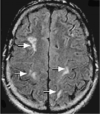Neuroparasitic infections: nematodes
- PMID: 16170738
- PMCID: PMC2678030
- DOI: 10.1055/s-2005-917662
Neuroparasitic infections: nematodes
Abstract
Globalization has produced an increase in the number of people at risk for contracting parasitic infection. Central nervous system infection by nematodal parasites can be devastating. Early recognition and treatment of infection can significantly decrease morbidity of the parasitic infection, as well as the risk of secondary superinfection. The clinical presentation, diagnosis, and treatment for five of the more common nematodal infections of the nervous system--Angiostrongylus spp., Baylisacaris procyonis, Gnathostoma spinigerum, Strongyloides stercoralis, and Toxocara spp.--is reviewed.
Figures





References
-
- Jindrak K. Angiostrongyliasis cantonensis (eosinophilic meningitis, Alicata's disease). Contemp Neurol Ser. 1975;12:133–164. - PubMed
-
- Chau TT, Thwaites GE, Chuong LV, et al. Headache and confusion: the dangers of a raw snail supper. Lancet. 2003;361:1866. - PubMed
-
- Andersen E, Gubler DJ, Sorensen K, et al. First report of Angiostrongylus cantonensis in Puerto Rico. Am J Trop Med Hyg. 1986;35:319–322. - PubMed
-
- Slom TJ, Cortese MM, Gerber SI, et al. An outbreak of eosinophilic meningitis caused by Angiostrongylus cantonensis in travelers returning from the Caribbean. N Engl J Med. 2002;346:668–675. - PubMed
Publication types
MeSH terms
Grants and funding
LinkOut - more resources
Full Text Sources
Other Literature Sources
Medical
Miscellaneous

